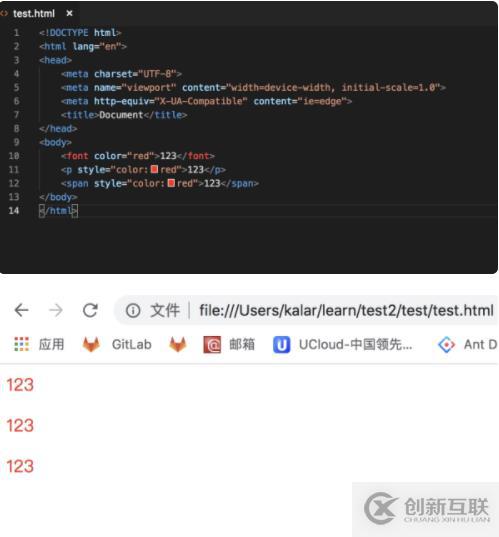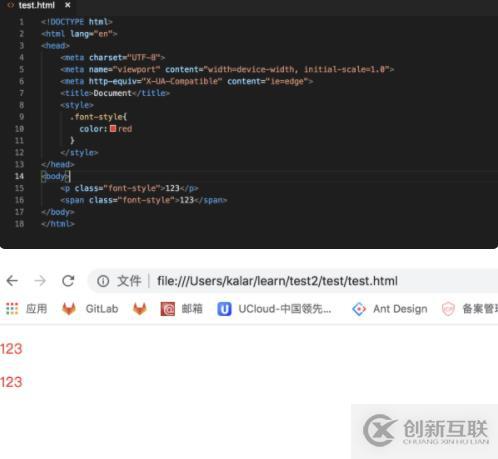怎么在Golang利用viper包對yaml的配置信息進行讀取-創(chuàng)新互聯(lián)
怎么在Golang利用viper包對yaml的配置信息進行讀取?針對這個問題,這篇文章詳細(xì)介紹了相對應(yīng)的分析和解答,希望可以幫助更多想解決這個問題的小伙伴找到更簡單易行的方法。

1、安裝
go get github.com/spf13/viper
2、編寫一個yaml的配置文件,config.yaml
database: host: 127.0.0.1 user: root dbname: test pwd: 123456
3、編寫學(xué)習(xí)腳本main.go,讀取config.yaml配置信息
package main
import (
"fmt"
"os"
"github.com/spf13/viper"
)
func main() {
//獲取項目的執(zhí)行路徑
path, err := os.Getwd()
if err != nil {
panic(err)
}
config := viper.New()
config.AddConfigPath(path) //設(shè)置讀取的文件路徑
config.SetConfigName("config") //設(shè)置讀取的文件名
config.SetConfigType("yaml") //設(shè)置文件的類型
//嘗試進行配置讀取
if err := config.ReadInConfig(); err != nil {
panic(err)
}
//打印文件讀取出來的內(nèi)容:
fmt.Println(config.Get("database.host"))
fmt.Println(config.Get("database.user"))
fmt.Println(config.Get("database.dbname"))
fmt.Println(config.Get("database.pwd"))
}4、執(zhí)行g(shù)o run main.go
輸出:
127.0.0.1 root test 123456
ok!
補充:go基于viper實現(xiàn)配置文件熱更新及其源碼分析
go第三方庫 github.com/spf13/viper 實現(xiàn)了對配置文件的讀取并注入到結(jié)構(gòu)中,好用方便。
其中以
viperInstance := viper.New() // viper實例
viperInstance.WatchConfig()
viperInstance.OnConfigChange(func(e fsnotify.Event) {
log.Print("Config file updated.")
viperLoadConf(viperInstance) // 加載配置的方法
})可實現(xiàn)配置的熱更新,不用重啟項目新配置即可生效(實現(xiàn)熱加載的方法也不止這一種,比如以文件的上次修改時間來判斷等)。
為什么這么寫?這樣寫為什么就能立即生效?基于這兩個問題一起來看看viper是怎樣實現(xiàn)熱更新的。
上面代碼的核心一共兩處:WatchConfig()方法、OnConfigChange()方法。WatchConfig()方法用來開啟事件監(jiān)聽,確定用戶操作文件后該文件是否可正常讀取,并將內(nèi)容注入到viper實例的config字段,先來看看WatchConfig()方法:
func (v *Viper) WatchConfig() {
go func() {
// 建立新的監(jiān)視處理程序,開啟一個協(xié)程開始等待事件
// 從I/O完成端口讀取,將事件注入到Event對象中:Watcher.Events
watcher, err := fsnotify.NewWatcher()
if err != nil {
log.Fatal(err)
}
defer watcher.Close()
// we have to watch the entire directory to pick up renames/atomic saves in a cross-platform way
filename, err := v.getConfigFile()
if err != nil {
log.Println("error:", err)
return
}
configFile := filepath.Clean(filename) //配置文件E:\etc\bizsvc\config.yml
configDir, _ := filepath.Split(configFile) // E:\etc\bizsvc\
done := make(chan bool)
go func() {
for {
select {
// 讀取的event對象有兩個屬性,Name為E:\etc\bizsvc\config.yml,Op為write(對文件的操作)
case event := <-watcher.Events:
// 清除內(nèi)部的..和他前面的元素,清除當(dāng)前路徑.,用來判斷操作的文件是否是configFile
if filepath.Clean(event.Name) == configFile {
// 如果對該文件進行了創(chuàng)建操作或?qū)懖僮? if event.Op&fsnotify.Write == fsnotify.Write || event.Op&fsnotify.Create == fsnotify.Create {
err := v.ReadInConfig()
if err != nil {
log.Println("error:", err)
}
v.onConfigChange(event)
}
}
case err := <-watcher.Errors:
// 有錯誤將打印
log.Println("error:", err)
}
}
}()
watcher.Add(configDir)
<-done
}()
}其中,fsnotify是用來監(jiān)控目錄及文件的第三方庫; watcher, err := fsnotify.NewWatcher() 用來建立新的監(jiān)視處理程序,它會開啟一個協(xié)程開始等待讀取事件,完成 從I / O完成端口讀取任務(wù),將事件注入到Event對象中,即Watcher.Events;

執(zhí)行v.ReadInConfig()后配置文件的內(nèi)容將重新讀取到viper實例中,如下圖:

執(zhí)行完v.ReadInConfig()后,config字段的內(nèi)容已經(jīng)是用戶修改的新內(nèi)容了;
其中這行v.onConfigChange(event)的onConfigChange是核心結(jié)構(gòu)體Viper的一個屬性,類型是func:
type Viper struct {
// Delimiter that separates a list of keys
// used to access a nested value in one go
keyDelim string
// A set of paths to look for the config file in
configPaths []string
// The filesystem to read config from.
fs afero.Fs
// A set of remote providers to search for the configuration
remoteProviders []*defaultRemoteProvider
// Name of file to look for inside the path
configName string
configFile string
configType string
envPrefix string
automaticEnvApplied bool
envKeyReplacer *strings.Replacer
config map[string]interface{}
override map[string]interface{}
defaults map[string]interface{}
kvstore map[string]interface{}
pflags map[string]FlagValue
env map[string]string
aliases map[string]string
typeByDefValue bool
// Store read properties on the object so that we can write back in order with comments.
// This will only be used if the configuration read is a properties file.
properties *properties.Properties
onConfigChange func(fsnotify.Event)
}它用來傳入本次event來執(zhí)行你寫的函數(shù)。為什么修改會立即生效?相信第二個疑問已經(jīng)得到解決了。
接下來看看OnConfigChange(func(e fsnotify.Event) {...... })的運行情況:
func (v *Viper) OnConfigChange(run func(in fsnotify.Event)) {
v.onConfigChange = run
}方法參數(shù)為一個函數(shù),類型為func(in fsnotify.Event)) {},這就意味著開發(fā)者需要把你自己的執(zhí)行邏輯放到這個func里面,在監(jiān)聽到event時就會執(zhí)行你寫的函數(shù),所以就可以這樣寫:
viperInstance.OnConfigChange(func(e fsnotify.Event) {
log.Print("Config file updated.")
viperLoadConf(viperInstance) // viperLoadConf函數(shù)就是將新配置注入到自定義結(jié)構(gòu)體對象的邏輯
})而OnConfigChange方法的參數(shù)會賦值給形參run并傳到viper實例的onConfigChange屬性,以WatchConfig()方法中的v.onConfigChange(event)來執(zhí)行這個函數(shù)。
關(guān)于怎么在Golang利用viper包對yaml的配置信息進行讀取問題的解答就分享到這里了,希望以上內(nèi)容可以對大家有一定的幫助,如果你還有很多疑惑沒有解開,可以關(guān)注創(chuàng)新互聯(lián)行業(yè)資訊頻道了解更多相關(guān)知識。
標(biāo)題名稱:怎么在Golang利用viper包對yaml的配置信息進行讀取-創(chuàng)新互聯(lián)
網(wǎng)頁網(wǎng)址:http://www.chinadenli.net/article44/dchiee.html
成都網(wǎng)站建設(shè)公司_創(chuàng)新互聯(lián),為您提供外貿(mào)建站、App開發(fā)、網(wǎng)站改版、網(wǎng)站制作、網(wǎng)站設(shè)計公司、用戶體驗
聲明:本網(wǎng)站發(fā)布的內(nèi)容(圖片、視頻和文字)以用戶投稿、用戶轉(zhuǎn)載內(nèi)容為主,如果涉及侵權(quán)請盡快告知,我們將會在第一時間刪除。文章觀點不代表本網(wǎng)站立場,如需處理請聯(lián)系客服。電話:028-86922220;郵箱:631063699@qq.com。內(nèi)容未經(jīng)允許不得轉(zhuǎn)載,或轉(zhuǎn)載時需注明來源: 創(chuàng)新互聯(lián)
猜你還喜歡下面的內(nèi)容

- 品牌網(wǎng)站建設(shè)對企業(yè)發(fā)展有哪些幫助 2022-10-29
- 成都品牌網(wǎng)站建設(shè)有哪些注意事項? 2016-09-19
- 品牌網(wǎng)站建設(shè)為什么價格各不相同? 2021-01-02
- 什么是高端品牌網(wǎng)站建設(shè) 2016-09-10
- 品牌網(wǎng)站建設(shè)應(yīng)該從哪些方面入手 2016-10-26
- 南陽本地品牌網(wǎng)站建設(shè)的幾個特點 2022-05-22
- 創(chuàng)新互聯(lián)談品牌網(wǎng)站建設(shè)的發(fā)展方向 2023-03-23
- 品牌網(wǎng)站建設(shè)公司通過什么方式打響品牌 2022-10-14
- 如何有效做好品牌網(wǎng)站建設(shè)? 2022-07-30
- 品牌網(wǎng)站建設(shè)的理念不可與其它類型混為一談 2022-10-21
- 北京高端品牌網(wǎng)站建設(shè)公司-專業(yè)高端網(wǎng)站制作 2021-02-11
- 品牌網(wǎng)站建設(shè)的主要市場建設(shè)要求明細(xì) 2016-10-31